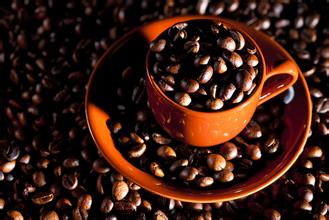How to cook deep-baked Colombian coffee beans
Colombia Coffee (Cafe de Colombia) is produced in Colombia and is one of the few single-origin coffees sold in the world under its name. In terms of quality, it has earned accolades that no other coffee can match. Colombia is more concerned with product development and production promotion than other producing countries. It is this, coupled with its superior geographical and climatic conditions, that makes Colombia coffee delicious and famous all over the world. Roasted coffee beans will release a sweet aroma, with acid in the sweet, bitter in the good quality characteristics, because of the appropriate concentration, often used in high-grade coffee blends. Colombia coffee exudes a light and elegant aroma, not as strong as Brazilian coffee, not as sour as African coffee, but a sweet light aroma, low-key and elegant.
Chinese Name Colombia Coffee Foreign Name Colombian Coffee The main ingredient of Emerald Coffee is Arabica coffee beans, Robusta coffee, washed coffee beans (Washedbeans) whether it contains preservatives No main edible effect can prevent radiation damage, has health care functions Suitable for people generally healthy people can drink, suffering from cardiovascular diseases, stomach problems, elderly women, pregnant women, vitamin B1 deficiency and cancer patients should try not to drink coffee Storage method Cool and dry place
directory
1 Historical origin
2 Species form
3 Growing environment
4 Quality of origin
5 Variety grades
6 Unique Flavors
7 Export management
8 Coffee culture
Historical source editor
Colombia coffee brands
Colombia coffee brands (9 photos)
The history of coffee cultivation in Colombia can be traced back to the Spanish colonial era in the sixteenth century. There are also many sayings about the history of coffee in Colombia:
One: it is said to have come from Haiti in the Caribbean via El Salvador in Central America.
Second, coffee beans were first introduced into Colombia in 1808 by a priest from the French Antilles via Venezuela. One of them is that the first coffee seeds from Colombia came from Venezuela through the province of Santander. [1]
Third: The earliest record of coffee cultivation in Colombia appears in a book entitled "The Illustrated Orinoca" by the Spanish missionary Jose Gumilla. He describes his travels on both sides of the Meta River in 1730, mentioning coffee plantations there. By 1787, other missionaries had spread coffee to other parts of Colombia.
Colombia, located in the northwest of South America, is a beautiful country with a long history. Indians have lived on this land since ancient times. It became a Spanish colony in 1531 AD and gained independence in 1819. It was renamed in 1886 to commemorate Columbus, the discoverer of the American continent. Colombia, beautiful mountains, beautiful scenery, pleasant climate, four seasons such as spring, fresh air. Colombia is rich in products, especially coffee, flowers, gold and emeralds known as the "four treasures." Today the country is the second largest coffee producer after Brazil, the world's largest exporter of Arabica coffee beans and the world's largest exporter of washed coffee beans. Often described as having a silky texture, Colombia coffee has the best balance of all coffees. It tastes soft, silky, and ready to drink, and it has earned a reputation that no other coffee can match: "green gold."
Species morphology editor
Colombia coffee plant morphology
Colombia coffee plant morphology (10 photos)
Colombia coffee varieties are mainly small coffee. Plants are small trees or large shrubs, 5-8 meters high, usually multi-branched at the base; old branches are gray, nodes expand, young branches glabrous, compressed. Leaves thinly leathery, ovate-lanceolate or lanceolate, 6-14 cm long, 3.5-5 cm wide, apex long acuminate, acuminate 10-15 mm long, base cuneate or slightly obtuse, rarely rounded, entire or shallowly undulate, glabrous on both surfaces, with or without pits in axils of lower veins; midvein raised on both surfaces of leaf blade, lateral veins 7-13 on each side; petiole 8-15 mm long; Stipules broadly triangular, born at the top of the young branches conical long pointed or awned tip, born at the top of the old branches are often pointed, long 3-6 mm. Cymes several clustered in leaf axils, each inflorescence 2-5 flowers, without pedicel or with very short pedicel; flowers aromatic, pedicels 0.5-1 mm long; bracts more or less united at base, dimorphic, 2 broadly triangular, nearly equal in length and width, 2 lanceolate, 2 times as wide, foliaceous; calyx tubular, 2.5-3 mm long, calyx limb truncated or 5 denticulate; Corolla white, length varies with species, generally 10-18 mm long, apically often 5-lobed, rarely 4-or 6-lobed, lobes often longer than corolla tube, apically often obtuse; anthers protruding outside corolla tube, 6-8 mm long; styles 12-14 mm long, stigmas 2-lobed, 3-4 mm long. Berry broadly elliptic when ripe, red, 12-16 mm long, 10-12 mm in diam., exocarp dural, mesocarp fleshy, sweet; seeds raised abaxially, ventral plane, longitudinally grooved, 8-10 mm long, 5-7 mm in diam. The flowers bloom from March to April. [2]
Planting environment editor
Colombia's favourable climate provides coffee with a true "natural pasture". Coffee trees in Colombia are mainly cultivated in the Andes mountains, on steep slopes up to 1,300 meters above sea level, where the annual temperature is about 18 degrees Celsius, the annual rainfall is 2000 to 3000 mm, the north latitude is 1 °-11 ° 15, the west longitude is 72 ° -78 °, and the specific altitude range can exceed 2.000 meters. By a particular combination of various factors, latitude, altitude, soil, plant origin of species and variety of coffee making in coffee growing areas of Colombia, climate in coffee growing areas and rain patterns resulting from dual paths of tropical convergence, changing topography throughout the day, luminosity, favorable temperature ranges throughout the year, distribution of moderate and rainwater, and some common cultural practices including selective harvesting and transformation processes, including washing and drying. Very suitable for coffee growth, mild climate, humid air, and can be harvested regardless of season. That's why Colombia coffee is so good. Colombia has three Cordillera mountains running north-south, right into the Andes. Coffee is grown along the highlands of these mountains. The terraces provide a diverse climate, with harvest seasons throughout the year and different types of coffee maturing at different times. And fortunately, unlike Brazil, Colombia doesn't have to worry about frost damage. There are approximately 2.7 billion recorded coffee trees in Colombia, 66 per cent of which are grown on modern plantations and the rest on small traditionally managed farms. [3]
The pure taste of Colombia coffee comes from the natural environment of Colombia, which has the most favorable conditions for coffee growth. But beyond that, it is inseparable from the hard work of local growers. In Colombia, coffee is cultivated on 1.07 million hectares, there are about 302,000 coffee plantations in the country, and 30 to 40 per cent of the rural population depends directly on coffee production. Although Colombia has many farms, they are not large. Each farm has an area of only about 2 hectares, and more than 80% of coffee plantations have only about 5000 coffee trees, with an average of 3000. Thus, agriculture in Colombia is of the small farm type. Locals plant tall trees or banana trees around coffee trees. During the seedling stage, coffee trees are sheltered to ensure a cool and humid environment for coffee growth. Due to the high humidity in the coffee forest, the small temperature difference, the slow maturity of coffee beans, which is conducive to the accumulation of caffeine and aromatic substances, the coffee quality is the best. [1]
Origin Quality Editor
Colombia coffee
Colombia coffee (7 photos)
Colombia coffee is the first coffee produced in Medellin, both in terms of yield and texture. It is characterized by full coffee beans, rich nutrition, moderate acidity, good balance, rich aroma and soft and smooth taste. In addition to Medellin, Armenia and Manizales, the capitals of two neighboring provinces in the south, are also famous coffee-producing areas. They were originally part of the Antichio province where Medellin is located, and the latter has a Caldas football team that participated in the last generation of the Toyota Cup. These three places formed the world-famous "coffee belt." [1]
Coffee workers pick coffee beans (also known as coffee cherries) by hand up the mountain, so they can carefully select and pick the most ripe and plump fruits. Most Colombia coffee beans are washed, and after moderate roasting, they have a light silky taste, sometimes with a little sour taste, unlike Brazilian coffee and Italian Expresso, which is known as "green gold." [4]
Variety Grade Editor
Colombia coffee varieties are mainly Arabica (coffee arabica), that is, small fruit coffee (coffee arabica), relatively speaking, large fruit coffee (coffee robusta) mostly grown in Africa of origin, such as the famous Madagascar coffee. There are several varieties of small fruit coffee. Brazil coffee, which has the largest yield in the world, has large seeds, strong adaptability and high fruit yield. In contrast, mild coffee produced in Colombia is a better variety, which is related to its special geographical location and climate environment. [1]
Colombia coffee is divided into more than 200 grades, coffee is very regional. Colombia beans are SUPERMO, followed by EXCELSO; however, specialty coffee above 18 beans (18/64 inches in diameter) can only be included in specialty coffee. Colombia coffee has a balanced flavor and a smoother taste, just like a gentleman in coffee. It has a wide range of producing areas, but the coffee in the central mountains is the best and the texture is thick. The most famous producing areas are Medellin, Armenia and Manizales, which are commonly referred to as "mam". The taste of "narino" is delicious and the quality is very good. Starbucks, which sells specialty coffee, is said to have exclusive rights to "narino supermo" coffee beans, which are common in their chain stores.
Unique flavor editor
Colombia coffee has a silky texture. People equate Colombia coffee with high quality, good taste. It is sour with sweet, low bitter, rich in nutrients, with a unique sour and alcohol taste, Colombia premium coffee acid, bitter, sweet taste of the three just right. Unique fragrance, after drinking, the fragrance fills the whole mouth. The aroma of the mouth and then exhale from the nose, the smell is very rich. Perhaps you will think it is too overbearing, because it will occupy people's taste buds, thoughts and even souls at the fastest speed. In people's lives, it is full of sour, sweet, bitter, astringent, the aroma of coffee is enough to take away everything in the mortal world. What people enjoy is not just a cup of coffee, but also the quiet moment coffee brings to people. Colombia Premium is characterized by its aroma, rich and thick, with a clear quality of acidity, high balance, it is memorable. [1]
There are two series of coffee in the world, one is "hard" coffee represented by Brazil, which tastes strong; the other is "soft" coffee represented by Colombia, which tastes light. The difference lies in the altitude of the origin and the planting method. Brazil grows coffee in hilly red soil more extensively, while Colombia produces coffee in mountainous black soil intensively. Colombia Premium has a rich, rich aroma with a clear, high-quality acidity, high balance, and sometimes nutty, lingering taste. Whether it is appearance, quality, Colombia super is quite good, just like a woman vaguely charming, charming and just right, people miss. [1]
Each kind of caffeine variety origin is different, has its own strong character, for example, masculine strong Mantenin, has the character of a man like steel; mellow fragrance of blue mountain coffee, the most gentle woman miss addiction. And always light aroma of Colombia premium coffee, the most suitable for those who like light sex. Such people do not want to drink coffee as a matter of sitting upright, from sour, sweet, bitter, astringent experience what profound philosophy of life, just want to simply drink a cup of delicious coffee, a cup of hot Colombia coffee, let these people realize that "the best state of life is rich quiet. Quiet, because get rid of the temptation of external fame; rich, because have the treasure of the inner spiritual world." They believe that the greatest happiness in life is to be able to harvest such a brilliant interpretation of the realm. [1]
Colombia coffee has a kind of bitter experience, clear astringency as life. Looking back on the past will feel more bitter sweet and tender, more want to let the mood a little longer stop in the beginning of awakening consciousness. Suffering is pain, purity calms people, and incense becomes a spiritual victory. [1]
Export Management Editor
Colombia is more concerned with product development and production promotion than other producing countries. It is this, coupled with its superior geographical and climatic conditions, that makes Colombia coffee delicious and famous all over the world. The status of coffee in Colombia is illustrated by the fact that all vehicles entering the country must be sprayed to avoid inadvertent disease and damage to coffee trees.
In addition, the management of coffee exports in Colombia is primarily the responsibility of the National Coffee Owners Federation. It is an unofficial trade organization with several government ministers as members. Colombia's law clearly stipulates that only private traders with Federation licenses can export coffee, in order to maintain the image of Colombia coffee in the world and ensure that the government obtains stable financial revenue from the coffee trade.
Coffee culture editor
Coffee is the pride of Colombia people, Colombia people like to talk about a few things, in addition to their football once ranked among the best in the world, is that they are proud of coffee. Coffee in Colombia is a pleasure, not only three times a day essential, streets are full of cafes, customers from morning to night, full of seats. Coffee shops do not say instant, now cooked and sold, miss with delicate porcelain bowl poured, respectfully sent to customers in front of their own free sugar. Indoor aroma pervades, sweet and delicious bowl, slowly taste endless aftertaste, no wonder local people each addicted to it.
At Andicchio University, every office has a small card that says "Coffee Break" and is likely to be hung at the door if the owner is out for a while. This reason seems to be justified, even for executives on duty. At any restaurant in Medellin, coffee is the free drink served to customers after dinner. [1]
Coffee is so deeply ingrained in Colombia that it has become indispensable for writers like García Marquez. One Hundred Years of Solitude, for example, which won him the Nobel Prize for Literature, has coffee in every chapter. Chapter 5 A dose of laudanum is added to the bride's coffee in order to prevent the wedding of the hero, Colonel Aureliano Buendía. To illustrate the colonel's wonder, Chapter 6 describes him as "once having enough strychnine in his coffee to poison a horse, and he survived." [1]
Chapter 7 describes the Colonel's state of mind before he was executed,"neither afraid nor nostalgic, but burning with anguish at the thought that this man's artificial death would prevent him from knowing the end of so many things left undone. Then the cell door opened and the guard came in with a cup of coffee." In The Colonel Who Has No Letters, García Marquez's supposedly favorite novel, he portrays a destitute retired officer whose embarrassment is felt from the outset: "The colonel opens the coffee-box and, sure enough, there is only a spoonful left

Important Notice :
前街咖啡 FrontStreet Coffee has moved to new addredd:
FrontStreet Coffee Address: 315,Donghua East Road,GuangZhou
Tel:020 38364473
- Prev

Introduction to the price of Colombian coffee beans all over the world
Kenya Coffee Raw Bean Kenya AA green bean Coffee entered Kenya in the 19th century, when Ethiopian coffee drinks were imported to Kenya through Southern Yemen. But it was not until the early 20th century that the bourbon was introduced by the St. Austin Mission. Kenyan coffee is mostly grown at an altitude of 1500 to 2100 meters and is harvested twice a year. Be correct
- Next

Grade Analysis of Ethiopian Coffee beans
Ethiopian coffee beans are divided into five levels. The first and second stages are washed beans. Washed beans Grade1 represents 3 defective beans per 300g raw beans, and Grade2 represents 4 defective beans per 300g. Gradc1 grade water washed beans are very rare and are generally difficult to buy. At present, all the washed beans exported from Ethiopia are Grade2 grade. The quality of sun-dried beans is Grade3 and Grad in order.
Related
- Does Rose Summer choose Blue, Green or Red? Detailed explanation of Rose Summer Coffee plots and Classification in Panamanian Jade Manor
- What is the difference between the origin, producing area, processing plant, cooperative and manor of coffee beans?
- How fine does the espresso powder fit? how to grind the espresso?
- Sca coffee roasting degree color card coffee roasting degree 8 roasting color values what do you mean?
- The practice of lattes: how to make lattes at home
- Introduction to Indonesian Fine Coffee beans-- Java Coffee producing area of Indonesian Arabica Coffee
- How much will the flavor of light and medium roasted rose summer be expressed? What baking level is rose summer suitable for?
- Introduction to the characteristics of washing, sun-drying or wet-planing coffee commonly used in Mantenin, Indonesia
- Price characteristics of Arabica Coffee Bean Starbucks introduction to Manning Coffee Bean Taste producing area Variety Manor
- What is the authentic Yega flavor? What are the flavor characteristics of the really excellent Yejasuffi coffee beans?

